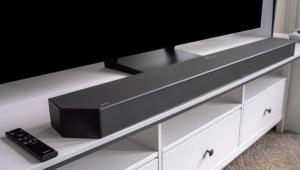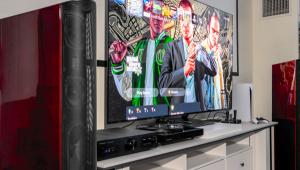LG has a huge headquarters in New Jersey, but because no assembly is actually done there, the main purpose of super mario bros the press conference I and several other reporters attended was to get to know LG's 2024 model-year sets.
Taking a Closer Look at LG's 2024 TV Lineup

My trip this time, however, wasn't recreational. It was to attend a press event at LG's New Jersey U.S. headquarters. LG is, of course, a Korean company. Nevertheless, its televisions and other products are assembled as near as practicable to its specific markets around the globe. In our area that's neither in or near New Jersey. "Instead, LG TVs bound for North America are actually assembled in Mexico. My understanding is that most of an LG TV's major subcomponents (the panels, processing boards, etc.) are built in Korea but connected together in Mexico to produce fully assembled televisions for sale in the North American market. The same is true in other regions around the world, with similar assembly facilities located close to those specific markets.
Other TV-makers operate in a similar fashion. There are reasons why the full assembly is done this way. Apart from locations in or near the originating company's home market — such as Japan, Korea, or China — the reasons for more remote assembly locations involve shipping, tariffs, labor costs, and other considerations.
LG's New Jersey headquarters is a very large facility but, since there's no assembly actually being performed there, the press event I attended, along with dozens of other scribes, was primarily devoted to familiarize us with LG's 2024 model-year sets. Particular attention was paid to the company's latest video processing, including the latter's AI (artificial intelligence) capabilities.
What AI Means in LG's TVs
I addressed the general concept of AI in my previous blog, but briefly put there's a huge gulf between highly sophisticated micro-processing, which the new LG models most certainly employ, and genuine AI, which doesn't yet exist except in science fiction. As I might define it, genuine AI involves a stationary or mobile device with computational abilities and speed beyond that of any individual human or reasonable group of humans, and with enough self-awareness as to be able to operate any device to which it can connect independent of human intervention — or even in defiance of human intervention.
That's a tall order, of course, and no current "AI" device can meet it, though perhaps someday it will (which is more than a little frightening!). Nevertheless, LG delivered a solid demonstration showing what their latest processing can accomplish (even if its use of the term "AI" is a bit of a stretch). My only reservation about such processing, which I've addressed before when discussing the use of creative processing to "improve" the picture, is whether or not this might alter the look intended by the program's director (and/or the cinematographer). LG claims that they've made allowances for this by studying a wide range of source material before settling on their algorithms. But can a survey of a wide range of material be suitable when applied to a specific film or other program? I asked this question but wasn't entirely convinced. It's also unlikely that a viewer unfamiliar with the director's intent can know for certain if the changes are appropriate or simply "better." We'll reserve judgment until we can see the results close-up and hands-on using familiar source material. In any case it should be possible for the video purist to turn off this AI processing.
LG also showed us the latest iteration of its webOS smart TV platform. That is, the opening screen used on all of today's televisions that offers a wide range of options from which the user can select the program desired. Like all such opening screens, LG's webOS is loaded with both free and for-pay selections, together with advertisements. Some of the latter can be turned off, but not all. As with the buttons on your TV's remote that offer, for example, direct access to YouTube, NetFlix, primeVideo, etc., these opening screen options aren't all offered to the viewer simply as a convenience. Rather, LG (and to be fair other set-makers as well) get paid for the advertisements and perhaps for providing the remote control selection buttons as well. It's been said that the profits this generates for the TV maker helps to keep its TV prices lower (and more competitive) than they might be otherwise.
The Scoop on QNED, Not OLED
LG's 2024 TVs are just starting to appear in stores this month, including its QNED and QNED mini-LED designs and, of course, LG's signature OLED models. Starting with its LCD-based QNEDs (often called QLEDs by other makers), there's an important distinction between LG's QNED and QNED mini-LCD designs. The former offers five different sizes, with the largest, 86-incher at an appealing $2,799. But while the standard QNEDs offers local LCD dimming (a must-have for high performance in an LED-LCD design), only the three QNED mini-LED models offer mini-LED local dimming. The largest of the three Mini designs, the 86-inch 86QNED90TUA (LG's model numbers are in desperate need of simplification!), at $3,299, should be well-worth its premium price of $500 over the non-mini 86-inch model. In either case, LG does not appear to specify the number of local dimming zones in its QNED TVs (and it's irrelevant in an OLED, where each pixel is its own dimmer).
OLED Refresh
Of course LG wouldn't be LG without new and updated OLED evo ranges, whose webOS platform has also been refreshed. While both the QNEDs and OLEDs offer the advanced micro-processing mentioned earlier, the OLEDs employ a somewhat more upscale processor. Whether this offers better results or merely indicates that OLEDs by their nature require more processing isn't clear. But in any event, all of LG's new models, whether OLED or QNED, also make use of the AI designation.
LG's OLEDs are available in two ranges: G4 and C4. The G4 uses LG's newest, Alpha 11 microprocessor and the C4 range uses the Alpha 9. The G4s also offers LG's Brightness Booster Max technology to provide a significant brightness increase over LG's best earlier OLEDs. The C4s also boast higher brightness than previous LG C-series OLEDs. Both OLED ranges boast image-enhancing features similar to those mentioned earlier.
The C4 OLED range offers six sizes, topping out with the 83-inch OLED83C4PUA at $5,399. The G4 range offers five models. The 83-inch G4 (OLED83G4WUA) is priced at $6,499. There's also a 97-inch, G4 (OLED97G4WUA) at $24,999!! The leap from 83-inches to 97-inches clearly demands a major investment. One reason why such a large size is so pricey is that all TV panels begin with huge piece of glass from which a number of smaller sized panels can be cut. The more panels you can get from this glass the lower the TVs from each final panel will cost. I suspect a 97-inch TV eats the entire original OLED panel!
- Log in or register to post comments


Fascinating insights into LG 2024 TV lineup and their assembly process. The discussion on AIs role in enhancing picture quality raises intriguing questions about maintaining artistic integrity. Looking forward to seeing these innovations in action.
Reliable Lawncare Services in Lafayette Colorado

Táto mobilná aplikácia ma veľmi prekvapila. Vďaka tejto Aplikácia v telefóne môžem podávať stávky kdekoľvek, stačí mať prístup na internet a telefón pri sebe! Som veľmi spokojný, pretože táto mobilná aplikácia je z hľadiska pohodlia ešte lepšia ako bežná počítačová verzia! Ak ste si túto aplikáciu ešte nenainštalovali, odporúčam vám to.

Sokszor nehéz megtalálni a tökéletes sportfogadási oldalt, de ez a link minden szempontból ideális. A gyors tranzakciók, a felhasználóbarát felület https://kaszinok-hu.com/casino/ice-casino/ és a nagy választék miatt ez az oldal a kedvencem. Különösen tetszik, hogy a magyarországi felhasználóknak szánt funkciók a helyi igényekre szabottak.
































































